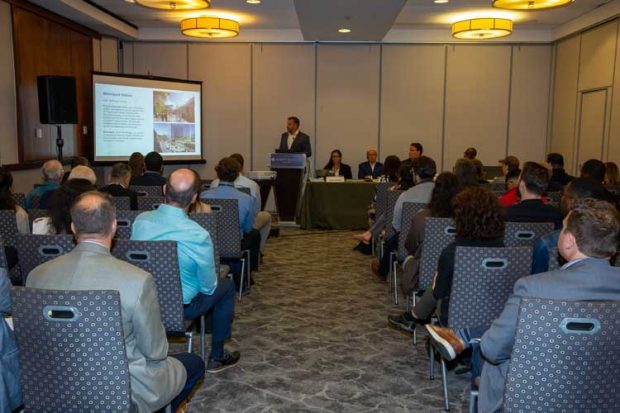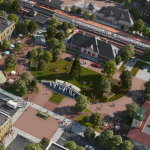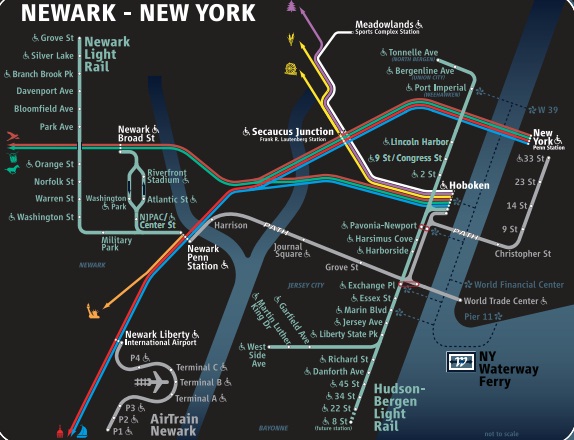New Jersey Future Blog
Next Stop: Transit Friendly Communities and TOD Opportunities
July 20th, 2023 by Zeke Weston

Next Stop: Transit Friendly Communities and TOD Opportunities session at the 2023 NJ Planning & Redevelopment Conference. Photo by Frank H. Conlon
Transit-friendly planning is a proactive, transit-focused approach developed by NJ Transit that is applicable to any community. Transit-friendly planning and transit-oriented development (TOD) are important components of smart growth because they allow people to live, work and play without having to rely on a car. During the second half of the 20th century, most of New Jersey’s 564 municipalities were developed and designed for the automobile, thus folks without cars are often excluded from accessing essential services. The existing 166 NJ Transit train stations provide community members with better access to employment opportunities and critical services; hence, transit-friendly planning improves transit equity and reduces carbon emissions. The second a transit rider steps off the bus or train, they become a pedestrian; thus, pedestrian-friendly development is inherently vital to TOD too. As the largest state-owned transit system in the U.S, NJ Transit has a prime opportunity to promote development, public transit ridership, and walkable communities through the TOD program in a way that takes advantage of existing infrastructure and does not consume our limited open space. Therefore, the session, “Next Stop: Transit Friendly Communities and TOD Opportunities” at the 2023 Planning and Redevelopment Conference, explored how to balance the needs of all transit users so that people of all ages and abilities can access transit facilities safely and comfortably.
Megan Massey, the Assistant Director of Transit Friendly Planning for NJ Transit, moderated the session’s panel discussion with various local government leaders. The panelists highlighted proven methods for inclusive community engagement. They included: Tim Dougherty, the Mayor of Morristown; Jason Cilento, the Mayor of Dunellen; Christopher Brown, the Director of Community Development for the City of Hoboken; and Owen Christensen, the Project Manager of Transit Oriented Development for NJ Transit. The panel sought to answer the following two essential questions: First, what is the history of TOD in your community? Second, how do you get more community buy-in for transit-friendly planning?
Massey began the session with an overview of NJ Transit’s transit friendly planning program. The program has two components: the transit friendly guide, and the implementation tools. The transit friendly guide provides recommendations for station accessibility, redevelopment, and equity, and includes planning guidance for active transportation and complete streets. Therefore, the guide helps communities plan and promote the design and development of their own TOD projects. The implementation tool provides communities with mechanisms for advancing their TOD projects. Some of the tools include community engagement strategies, non-legislative actions, land-use guidance, building regulations, and various planning approaches. Thus, the implementation tool helps turn community TOD aspirations into a reality.

Christopher Brown, Director of Community Development, City of Hoboken, speaking during the 2023 NJ Planning & Redevelopment Conference. Photo by Frank H. Conlon
The three panelists from municipal governments highlighted components needed for the successful implementation of TOD. Morristown’s Dougherty insisted that planning must be prioritized during the process, imploring municipalities to “let the planners plan.” This means hiring independent professionals, not the elected official’s political appointees. Cilento, the Mayor of Dunellen, expressed the importance of community engagement. Public input is critical for transit-friendly planning; therefore, Dunellen conducts annual community surveys to inform the town on how community members feel about the current state and changes they wish to see going forward. Christopher Brown, of Hoboken, emphasized the importance of pedestrian design and safety. Hoboken’s zero traffic fatalities for 3 consecutive years is proof of the city’s continuous commitment to pedestrian safety. TOD cannot be successful without prioritizing pedestrians, nor is public transit accessible if it is surrounded by car-oriented development. Hence, Hoboken’s Hudson Place and Warrington Plaza are currently being redesigned to be more pedestrian-friendly like the rest of the city.
Christensen presented a few of NJ Transit’s current TOD projects. The Somerville station project is located on the Raritan Valley rail line. The development will have 512 residential units, including 356 apartments and 156 townhomes, and will provide community and open spaces, revitalize the station area, and enhance access to downtown Somerville. The Orange station project, located on the Morristown rail line, is a multi-phase residential development to build 410 apartment units in two phases. Additionally, the project will increase pedestrian safety, improve station access, and enhance community connections. The Metropark station project on the Northeast Corridor rail line will be home to a mixed-use development that includes 225 apartments, of which 20% of those apartments are affordable units. The Metropark mixed-use development will include a commercial office building and ground floor retail space. Importantly, the project makes station-area, circulation, offsite traffic mitigation, and pedestrian-friendly improvements to the area.

Owen Christensen, Project Manager, Transit Oriented Development, NJ TRANSIT, speaking during the 2023 NJ Planning & Redevelopment Conference. Photo by Frank H. Conlon
Transit friendly planning and TOD projects are vital for promoting equitable access throughout NJ. Folks who do not drive or own a car are unjustly excluded from many of society’s opportunities. Developing around transit centers improves the ability for community members to safely use public transportation to access critical needs, like employment opportunities and social services. The accessibility, equity, and safety benefits of TOD are evident, but they are not the only reasons for promoting transit-friendly planning. TOD is instrumental for addressing NJ Transit’s fiscal cliff as a means to build increased ridership through developing transit adjacent housing. As the need for TOD increases, demand for NJ Transit’s projects will increase too, presenting a unique opportunity for transit-oriented planning projects to improve the financial standing of NJ Transit. Therefore, TOD has the potential to benefit both municipalities and the state as a whole.
Related Posts
Tags: active transportation, community, Complete Streets, Pedestrian, pedestrian-oriented developemt, Smart Growth, TOD, Transit, transit-friendly planning, Transit-oriented Development, Transportation
















